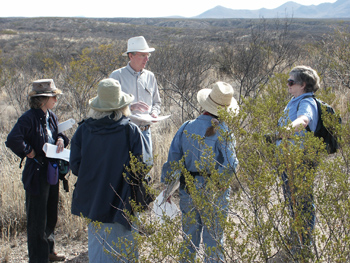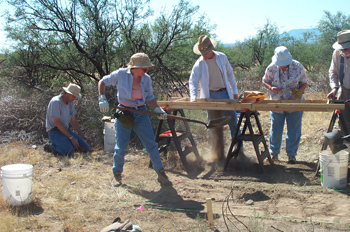Banner image by Bernard Siquieros
 From 1990 to 1995, a team of volunteers and archaeologists from Archaeology Southwest undertook systematic archaeological survey of southeastern Arizona’s San Pedro River valley. The survey covered 75 linear miles between the towns of Winkleman and Benson. The team recorded almost 500 sites and collected thousands of artifacts. To learn more about this project, click here.
From 1990 to 1995, a team of volunteers and archaeologists from Archaeology Southwest undertook systematic archaeological survey of southeastern Arizona’s San Pedro River valley. The survey covered 75 linear miles between the towns of Winkleman and Benson. The team recorded almost 500 sites and collected thousands of artifacts. To learn more about this project, click here.
Between 1999 and 2001, Archaeology Southwest followed up with a mapping and test excavation program. Work focused on large residential sites that dated to the period between 1200 and 1450. Together with a team of volunteers and interns, Archaeology Southwest staff excavated limited-impact test units in trash deposits at twenty-nine sites. To read more about this work, click here.
 We learned new information about subsistence practices (what people were eating and how it was cultivated or obtained), pottery making and exchange, and obsidian exchange in the valley. By looking carefully at design changes on specific kinds of painted pottery (Roosevelt Red Wares, or Salado polychromes) and establishing a tighter chronological sequence, we were able to date sites and portions of sites more closely.
We learned new information about subsistence practices (what people were eating and how it was cultivated or obtained), pottery making and exchange, and obsidian exchange in the valley. By looking carefully at design changes on specific kinds of painted pottery (Roosevelt Red Wares, or Salado polychromes) and establishing a tighter chronological sequence, we were able to date sites and portions of sites more closely.
Taken together with results from earlier excavations by other institutions, such as the Amerind Foundation, this work enabled us to convincingly demonstrate the migration of Kayenta groups from what is now northeastern Arizona into the San Pedro valley, which was already inhabited. Several lines of evidence indicated that initial tensions between migrants and local groups eased over years of living in neighboring communities. In time, the descendants of these two groups formed a new, inclusive identity: Salado.
We decided to see if we could detect migrants from the north in other areas of the southern Southwest. We hoped to assess their impacts in these other regions, as well. We wondered if migration had any bearing on population decline across the southern Southwest in the 1300s and 1400s. This was the next phase of our research.
VIDEO: The Jewel in the Crown—Preservation Archaeology in the San Pedro River Valley